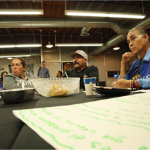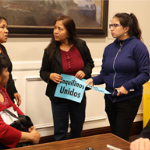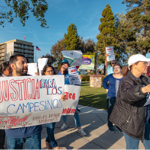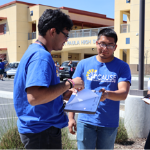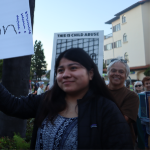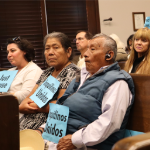Improving Representation in the Central Coast
Since CAUSE’s earliest days, we have worked to strengthen voting rights and fair representation for our communities. Despite people of color making up the majority of the Central Coast’s population, we are deeply underrepresented at every level of government and policy-making, impacting our communities’ access to housing, education, healthcare, transportation, quality jobs, a healthy environment and more. We won historic redistricting in 2011, transforming state and federal representation for the Central Coast after the creation of California’s first Citizens Redistricting Commission. In 2014, we began advocating for city councils and school districts to shift from at-large to district-based elections to guarantee a voice for working-class immigrant neighborhoods that are often outvoted by wealthier neighborhoods in citywide elections. Smaller neighborhood districts also make local elections more accessible for grassroots candidates without big money from powerful interests. Following the 2020 Census, CAUSE worked to ensure our communities’ voices would be heard as every local, state, and federal district was redrawn, securing transformative victories throughout the Central Coast.
CAUSE organizers, community leaders, and coalition partners spent long hours developing community-led maps and testifying at public hearings to make the case that local governments need to be more reflective and accountable to the community. Through the efforts, we increased representation in the region for communities of color, renters, immigrants, young people, and working-class neighborhoods.
For decades, Oxnard, the Central Coast’s largest and most racially diverse city, has been split in the state assembly, neglecting our community of a political voice in the state capitol. Following the 2020 census, we had a once in a decade opportunity to bring fair representation to Oxnard through redistricting – we capitalized on that moment. CAUSE organized and mobilized our community to the California Redistricting Commission and won a new assembly district for our region that united working-class immigrant neighborhoods from Oxnard and Port Hueneme to the Westside of Ventura, Santa Paula, and Fillmore. For the first time in history, we secured a district with majority voters of color in Ventura County for representation in Sacramento.
With the growing Latino population of the County of Ventura, for the first time the county faced a legal obligation to create a second majority Latino voting district to ensure fair representation due to the county’s longstanding history of racially polarized voting. CAUSE organized a countywide coalition, mobilizing the community to attend public hearings, engage local news, and meet with county supervisors and staff to demand the county create two Latino majority districts. CAUSE brought together a coalition of 15 organizations from across the county, particularly Oxnard and the Santa Clara Valley, working collectively through seven different draft maps to balance the needs of communities. While our preferred map was not chosen, we generated over 50 public comments, built a powerful coalition, and won the historic change of creating two Latino majority districts in the county.
Meanwhile, Santa Barbara County had created its first-ever Citizens Redistricting Commission, promising a historic shakeup of its board of supervisor districts. Santa Barbara County has long had an imbalance between a majority white but liberal-leaning South County and a North County led by a conservative political establishment not reflecting its rapidly growing Latino majority. This historic underrepresentation and political marginalization of immigrant communities has resulted in a Santa Barbara County that is nearly half Latino in population without a single Latino county supervisor.
CAUSE mobilized allies countywide, resulting in over 100 public comments to the Commission, with the goal of creating a supermajority Latino district in Northern Santa Barbara County to overcome the deep racial disparities in voter registration and turnout. While our preferred district lines for other parts of the county were not selected, the new 5th District almost exactly mirrored our proposal, resulting in a new district to be the voice of Santa Barbara County’s most underrepresented immigrant and farmworker neighborhoods.
In Oxnard and Santa Maria, the high school districts transitioned into district-based elections from at-large for the first time after the Census. CAUSE has organized students in these school districts for many years, making up the core of our base of youth leaders. We partnered with sister organizations that also engage youth in these school districts, Future Leaders of America (FLA) and the Mixteco/Indigena Community Organizing Project (MICOP) to create a youth-led process to choose and advocate for new maps that better reflected the community. In both school districts, the adoption of new district maps has resulted in greater representation of the community. We also supported FLA with mapping technical expertise in their successful campaign to draw districts for the Santa Barbara Unified School District.
When the city of Ventura originally moved to district elections after CAUSE fought for representation for the majority Latino Westside, the maps were shaped by gerrymandering by incumbent elected officials. During the redistricting cycle we had an opportunity to advocate for new districts. CAUSE partnered with the local Chamber of Commerce to show broad-based, non-ideological support for a map that would be less gerrymandered, better align with local neighborhoods, and improve diverse representation. These efforts resulted in a majority Latino voter district on the Westside and two districts with strong influence of voters of color in Montalvo and Saticoy.
Santa Paula remained the last city where CAUSE had a local chapter that remained in at-large elections for city council, even though civil rights activists have been fighting to change that for two decades. In February 2023, thanks to our organizing alongside our partner Santa Paula Latino Town Hall, the Santa Paula City Council voted to adopt district elections delivering better and more accessible representation for the community.
The Santa Paula district map that was adopted was drawn with the community, and was one of the final maps that our coalition submitted. The new map preserves historic neighborhoods and strengthens representation for working-families, immigrants, and renters in the city. The map also increases the voice of neighborhoods in the city’s flatlands as most councilmembers that represented the city used to live on the hillsides.
The recent representation victories in the Central Coast set our communities up for success to address the housing crisis, protect and improve immigrant workers’ rights, and deliver environmental justice for our region. Support our next fight in the 805 by donating today!





